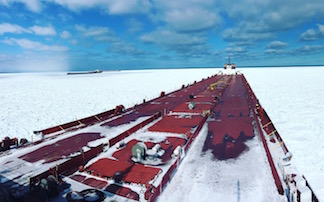The following is text of a news release from the Lake Carriers' Association (LCA):
(CLEVELAND) — The U.S. economy lost more than $1 billion in business revenue and 5,421 jobs due to inadequate icebreaking capabilities on the Great Lakes during the 2018-2019 winter season.
Due to this loss of business revenue, the federal government missed out on more than $125 million in taxes and in addition $46 million was lost by state and local governments. For perspective, that loss means the U.S. government could build a new Great Lakes icebreaker and recoup those costs in two years.
“In response to a question at a recent congressional hearing, we polled our members about the delays they incurred due to inadequate icebreaking this winter,” said Jim Weakley, president of Lake Carriers’ Association. “Once we had the total number of tons delayed and total hours they were delayed, we were able to calculate the additional cargo we could have moved had the Coast Guard been able to meet the needs of commerce. Using the economic model updated in July of 2018 by Martin Associates, it was determined that U.S. economy lost over $1 billion as a result of the steel not made and the power not generated by the coal and iron ore the U.S.-flag fleet could not move.”
With robust icebreaking capabilities paving the way for commercial shipping, U.S.-flag lakers could have carried 4 million additional tons of iron ore and 879,210 additional tons of coal. In other words, lakers could have done an additional 860 trips delivering iron ore to steel mills and 21 trips delivering coal to power generation plants.
“A dynamic fleet of icebreaking assets is absolutely critical for our regional and national economy, especially our domestic steel and power generation industries which were hit hard this past winter season,” said Mark Barker, president of The Interlake Steamship Co., which moves nearly 20 million tons annually crisscrossing the Lakes more than 500 times between March and January. “Robust icebreaking capabilities enable the Coast Guard to deliver on its mission to facilitate the flow of commerce across our Great Lakes.”
“The U.S. Coast Guard was down four icebreakers for a significant period of time this past winter and for the first time in memory, no icebreaker was left on Lake Superior when the Soo Locks closed from Jan. 15 to March 25," said Mark Pietrocarlo, the Lake Carriers’ Association’s board chairman. "One icebreaker took 17 months to repair, one was on the East Coast for a major overhaul, and two others missed more than a month of icebreaking.”
“The economic impact on our customers and the supply chain they enable is significant and points out the need for a new icebreaker for the Great Lakes,” Pietrocarlo said. “Given the lost tax revenue the economic model calculated for the federal government, the payback period to the Treasury for the vessel is two years. Infrastructure investment isn’t just about fixing the roads, we also need to maintain our marine highways.”
About the study
To estimate the economic impact of inadequate icebreaking during the typical ice conditions experienced on the Great Lakes during the 2018-2019 winter season, the Lake Carriers’ Association asked U.S.-flag carriers to report their delays in hours and the number of tons carried during their delays.
The types of delays included being beset in the ice, at anchor awaiting an icebreaker, having to slow down due to inadequate icebreaking, waiting for Coast Guard permission to proceed, and waiting for a convoy to form.
In addition, hours lost due to repairing ice damage to vessels and the hours lost by vessels that delayed their initial sailing times due to inadequate icebreaking were factored in to the total.
The LCA aggregated the fleet’s lost hours and tons delayed and determined that a total of 409,729 tons of coal were delayed for 206 hours. It also calculated that 2.18 million tons of iron ore were delayed for a total of 1,586.5 hours. Since the vessels reporting were a combination of “footers” and smaller vessels, the LCA used an average of 42,000 tons per trip. It was also assumed that a typical round trip for a U.S.-flag laker takes 96 hours.
The data, showing tons by commodity, lost by the U.S.-flagged Great Lakes fleet, was supplied by the Lakes Carriers’ Association to Martin Associates. The July 2018 updated economic impact study of the Great Lakes-St. Lawrence Seaway U.S.-flagged fleet developed jobs per ton and economic impact per ton ratios for iron ore, coal, limestone/aggregates and other dry bulk cargo. These ratios were then applied to the estimated loss of 4 million tons of iron ore and 900,000 tons of coal for the relatively average winter of 2018-2019. The economic impacts of these delays are presented in terms of jobs and business revenue in table above.
For more information about 2018 economic impact study of the Great Lakes, click here.

